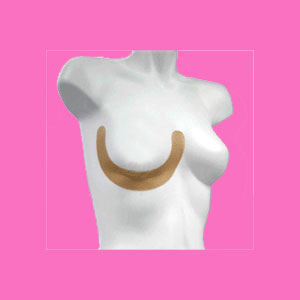
The inframammary fold is the anatomical line where the lower breast mound meets the chest wall. This is the area immediately under the breast, also known as the breast seam, inframammary seam or inframammary crease. This bodily region is used as an entry point during many cosmetic breast surgery procedures. The breast fold is also an anatomical marker commonly used to determine degrees of ptosis in the breasts.
The breast fold is actually very important to breast form and function. This article details why the inframammary crease is vital to beautiful breasts.
Inframammary Crease Defined
The breast crease is the line between the lower chest and the rising tissue of the breast mound.
The inframammary crease is where the lower breast actually connects to the rest of the torso.
The area is rich is collagen and elastin, since these are required to help support the breast tissue.
In a young or small breast, the inframammary fold will be visible to the eye upon casual observation. The breast will not hang over the fold in these cases.
As breast size, age and other lifestyle changes affect the tissue, it is common for the position of the breast to change in relation to the fold. Ptosis or breast size can cause the breast to descend over the fold, concealing it from view. Eventually, the nipple and the majority of glandular breast tissue might wind up below the inframammary crease.
Breast Surgery on the Inframammary Fold
Inframammary incisions are common in every type of surgical breast procedure including: breast augmentation, breast reduction and breast lift. This incision runs along the breast fold and is usually easy for the surgeon to conceal the scar.
This type of incision is advantageous, since it gives direct access to the breast interior, but does not disturb the delicate nerves and glandular structures near the nipple. The breast crease incision is especially aesthetic in women who are undergoing a large augmentation, since the breasts will lie back on top of the scar, completely hiding it when the women is in an upright position.
Inframammary crease incisions can be very small, or very large, depending on the type of procedure being performed and other factors, such as the size and style of breast implants used during an augmentation.
Some surgeries actually move the natural inframammary fold as part of a mastopexy procedure. By lowering the natural fold, the breast can be re-sculpted back into a rounder, firmer and fuller shape with a more youthful appearance.
Inframammary Crease Facts
Women who are emotionally troubled by ptotic breasts usually display considerable breast tissue and nipple placement at or below the inframammary crease. Although there is nothing at all wrong with this breast position, it can be a constant reminder of age or childbirth-related trauma to the breast tissue.
This ptosis can cause rage to a woman’s emotional spirit, although this anger is usually repressed in the subconscious mind. In order to overcome this mental anguish, it might be advisable to consult with a qualified cosmetic surgeon to learn about options which can renew the breasts and recreate a youthful look and feel.
If you are considering breast enhancement surgery, ask the doctor if an inframammary incision might be the right type of operative entry for your particular situation.



